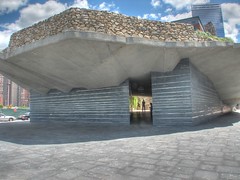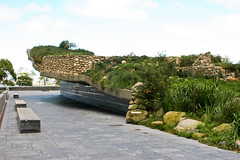Irish Hunger Memorial
From The Peopling of New York City: Irish Communities
Migration: First Wave | Second Wave | Irish Hunger Memorial
The Irish Hunger Memorial recreates a rural Irish landscape with an authentic Famine-era stone cottage, stone walls, fallow potato fields and the flora on the north wetlands of Ireland. The memorial is located on Vesey Street and North End Avenue in Battery Park City, Manhattan, New York City. It serves as a metaphor for the Great Irish Famine and a reminder that hunger today is often the result of lack of access to land. The theme of the memorial is to encourage visitors address current and future hunger worldwide.The abandoned cottage in the central to the project was donated by his extended family, the Slacks of Attymass, County Mayo, Ireland. It was disassembled in Ireland and reconstructed on the Memorial's half-acre site as an expression of solidarity to those who left from those who stayed behind.
From the cottage, a path winds through a rugged landscape thickly covered with native Irish plants. Ascending to an overlook twenty-five feet above the ground, the visitor encounters a breath-taking view of the Statue of Liberty and Ellis Island beyond. This landscape is cantilevered over a stratified base of glass and fossilized Irish limestone. Nearly two miles of backlit text are installed behind frosted glass, wrap around the exterior of the Memorial and into the passageway leading to the cottage while accounts of world hunger are heard from an audio installation overhead. The text includes some 110 quotations, including autobiographies, letters, oral traditions, parliamentary reports, poems, songs and statistics. The texts merge past and present accounts of famine and can be updated to respond to new hunger crises. The audio narration overhead provides updated information about famine sites and conditions.





